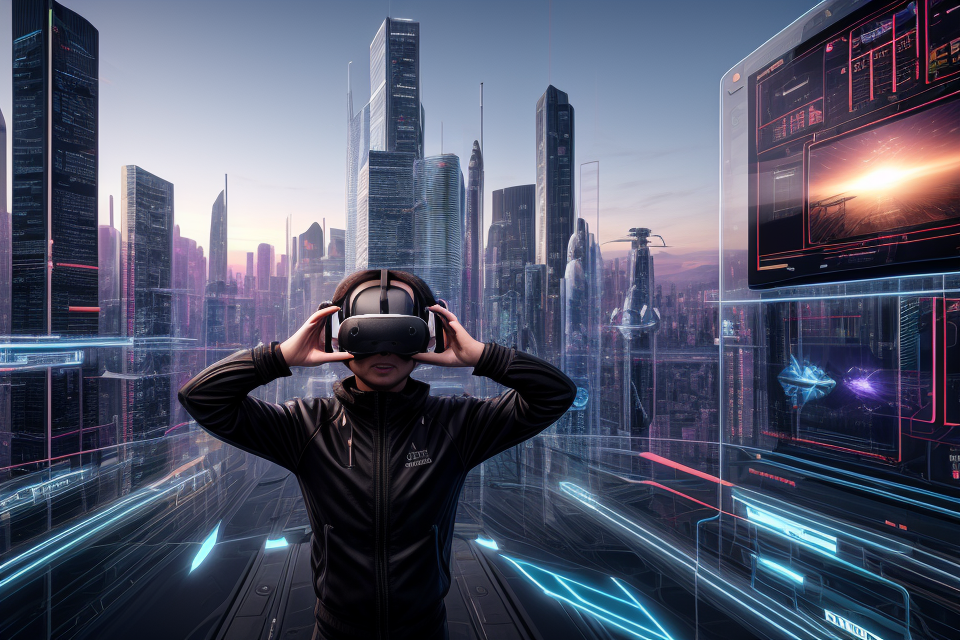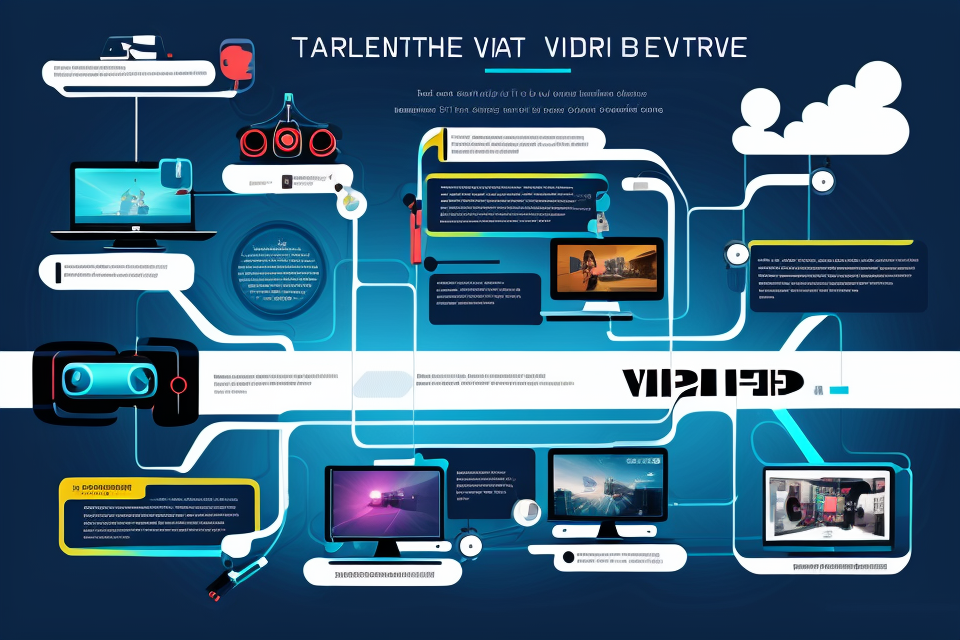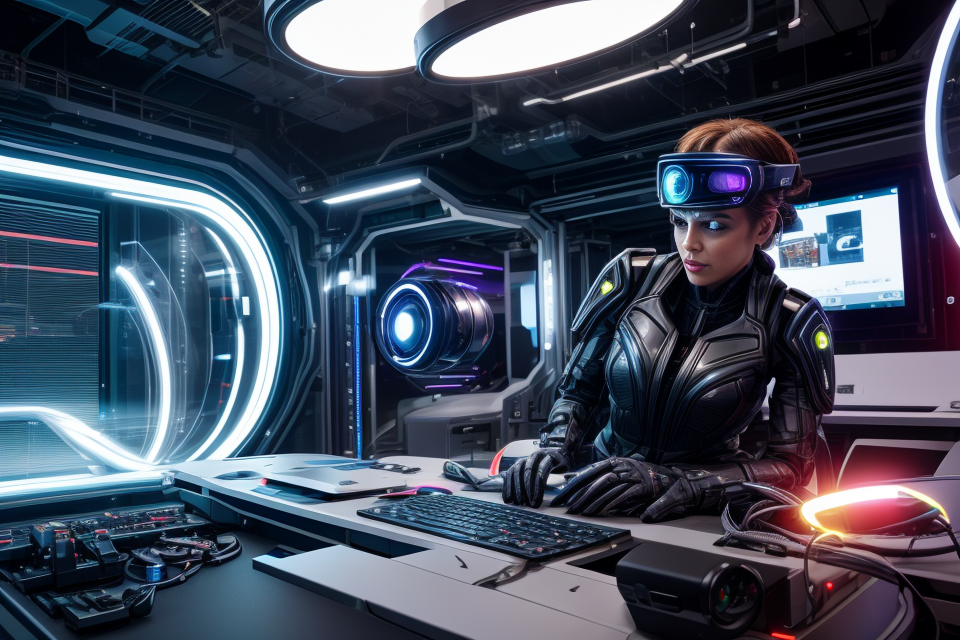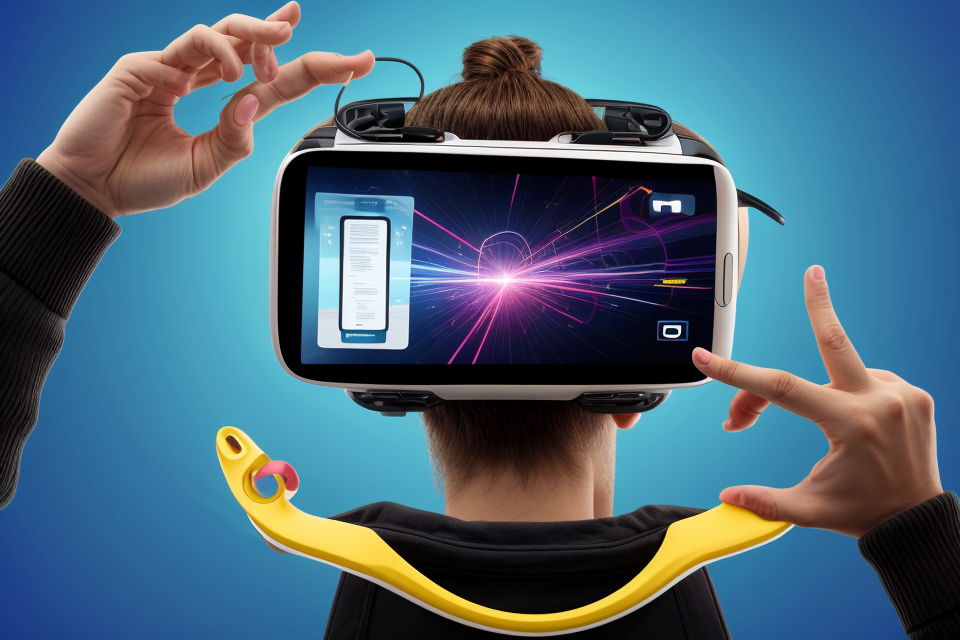Are you ready to immerse yourself in a whole new world? Virtual Reality (VR) is the ultimate game-changer, transporting you to an alternate reality where you can interact with virtual objects and environments. But what makes VR so mesmerizing? The answer lies in its three key elements. Get ready to explore the thrilling world of VR as we delve into the three elements that bring this fantastical experience to life. Buckle up, and let’s dive in!
The three key elements of virtual reality (VR) are immersion, interactivity, and presence. Immersion refers to the ability of VR to fully immerse the user in a digital environment, making them feel as if they are physically present in that space. Interactivity allows users to interact with the virtual environment in a way that feels natural and intuitive, creating a sense of agency and control. Presence refers to the feeling of being truly present in the virtual environment, which can be achieved through advanced technology such as haptic feedback and motion tracking. These three elements work together to create a highly immersive and engaging experience that can be used for a wide range of applications, from gaming and entertainment to education and therapy.
The Basics of Virtual Reality
Virtual Reality Defined
Virtual reality (VR) is a computer-generated simulated experience that can be similar to or completely different from the real world. It is a three-dimensional, computer-generated environment that is designed to simulate a real-world environment. VR can be experienced through a variety of devices, including head-mounted displays, smartphones, and gaming consoles.
One of the key characteristics of VR is its ability to create a fully immersive experience for the user. This is achieved through the use of stereoscopic imaging, which creates the illusion of depth by simulating the way that the human eye perceives the world. In addition, VR typically incorporates audio and haptic feedback to further enhance the sense of immersion.
Another important aspect of VR is its interactivity. Unlike traditional media, such as movies or television, VR allows the user to interact with the virtual environment in a variety of ways. This can include movement through the environment, manipulation of virtual objects, and even communication with other users in the same virtual space.
Finally, VR is often used for entertainment and gaming purposes, but it also has a number of practical applications. For example, VR can be used for training and simulation in fields such as medicine, aviation, and military, as well as for education and therapy.
Overall, the key elements of VR include its ability to create a fully immersive experience, its interactivity, and its practical applications. These elements work together to make VR a powerful tool for a wide range of applications.
How Virtual Reality Works
To understand how virtual reality works, it is important to first understand the three key elements that make up a virtual reality experience:
- Immersive environments: These are the artificial worlds that are created by virtual reality technology. They are designed to be as realistic as possible, and can include sights, sounds, and even touch.
- Sensory feedback: This is the way in which the virtual reality system interacts with the user’s senses. For example, the system might use headphones to provide sound, or it might include a haptic feedback system that allows the user to feel tactile sensations.
- Interaction: This is the way in which the user is able to interact with the virtual environment. This can include using controllers or other input devices, or it can involve using gestures or other physical movements.
By combining these three elements, virtual reality is able to create a highly immersive experience that can simulate a wide range of environments and activities.
The Three Key Elements of Virtual Reality
Element 1: Immersion
Immersion is the first key element of virtual reality. It refers to the ability of the virtual environment to completely engage the user, making them feel as if they are truly in the virtual world. The level of immersion can vary depending on the virtual environment and the user’s experience, but it is a crucial aspect of virtual reality that affects the overall user experience.
Here are some ways to achieve immersion in virtual reality:
- Realistic graphics: The virtual environment should have high-quality graphics that are realistic and immersive. This can include realistic textures, lighting, and 3D models that create a believable environment.
- Interactivity: The virtual environment should be interactive, allowing the user to interact with objects and other users in the environment. This can include physical interactions, such as picking up and using objects, or social interactions, such as chatting with other users.
- Sensory feedback: The virtual environment should provide sensory feedback to the user, such as haptic feedback for touch or audio feedback for sound. This can enhance the user’s sense of presence in the virtual world and make the experience more immersive.
Overall, immersion is a critical aspect of virtual reality that can make the experience more engaging and enjoyable for the user. By creating a realistic and interactive virtual environment, users can feel as if they are truly in a different world, which can lead to a more immersive and memorable experience.
Element 2: Interactivity
Explanation of Interactivity in Virtual Reality
Interactivity is a critical element of virtual reality, which refers to the ability of the user to interact with the virtual environment. This can include a wide range of actions, such as moving around in the environment, interacting with objects, and performing various tasks.
Importance of Interactivity in Virtual Reality
Interactivity is essential to creating a truly immersive virtual reality experience. Without the ability to interact with the environment, users may feel disconnected from the experience and may not fully engage with the virtual world.
Types of Interactivity in Virtual Reality
There are several types of interactivity in virtual reality, including:
- Physical Interactivity: This type of interactivity involves the user’s physical movements, such as walking, running, or jumping, to navigate the virtual environment.
- Gestural Interactivity: Gestural interactivity involves the use of hand gestures or body movements to interact with objects or perform actions in the virtual environment.
- Voice Interactivity: Voice interactivity allows users to communicate with other users or virtual characters in the environment using voice commands or natural language processing.
- Haptic Interactivity: Haptic interactivity involves the use of haptic feedback, such as vibrations or force feedback, to provide a sense of touch or feedback to the user.
Advantages of Interactivity in Virtual Reality
Interactivity offers several advantages in virtual reality, including:
- Immersion: Interactivity helps to create a more immersive experience by allowing users to interact with the virtual environment in a more natural and intuitive way.
- Engagement: Interactivity can increase user engagement and motivation by providing a sense of agency and control over the virtual environment.
- Learning: Interactivity can also enhance the learning experience by allowing users to interact with virtual objects and environments in a more interactive and hands-on way.
Overall, interactivity is a critical element of virtual reality that can enhance the user experience, increase engagement, and provide a more immersive and interactive virtual environment.
Element 3: Presence
Understanding Presence in Virtual Reality
Presence is a crucial aspect of virtual reality, as it is the feeling of being fully immersed in the virtual environment. It is the sensation that the user is not simply observing the virtual world but is actually experiencing it as if it were real.
Factors Affecting Presence
Several factors contribute to the feeling of presence in virtual reality. These include:
- Sensory feedback: The virtual environment should provide realistic and consistent sensory feedback, such as haptic feedback for touch and 3D audio for sound, to enhance the user’s sense of immersion.
- Graphical realism: The virtual environment should be visually convincing and detailed, with realistic textures, lighting, and animations to create a believable virtual world.
- Interactivity: The user should have the ability to interact with the virtual environment in a natural and intuitive way, allowing them to explore and manipulate objects within the virtual world.
- Personalization: The virtual environment should be customizable to fit the user’s preferences and needs, allowing them to personalize their experience and feel more connected to the virtual world.
The Importance of Presence in Virtual Reality
Presence is essential for creating a fully immersive virtual reality experience. Without a strong sense of presence, users may feel detached from the virtual environment and less likely to engage with it fully. High levels of presence can lead to increased user engagement, immersion, and satisfaction with the virtual reality experience.
However, achieving a strong sense of presence can be challenging and requires careful consideration of various factors, such as the quality of the virtual environment, the user’s personal preferences, and the type of experience being created.
Overall, presence is a critical element of virtual reality that can significantly enhance the user’s experience and create a more engaging and immersive virtual world.
Additional Elements of Virtual Reality
Sensory Feedback
Sensory feedback is a crucial aspect of virtual reality that involves the use of sensors to provide users with physical feedback while they are immersed in a virtual environment. This technology aims to enhance the overall immersive experience by making the virtual environment more realistic and engaging.
Here are some of the key points to consider when it comes to sensory feedback in virtual reality:
- Types of Sensors: Sensors used in virtual reality can be categorized into several types, including vibration, temperature, and olfactory sensors. Vibration sensors are used to provide tactile feedback through haptic technology, while temperature sensors are used to create thermal sensations in the virtual environment. Olfactory sensors, on the other hand, are used to create smells that enhance the user’s sense of smell.
- Implementation: Sensory feedback can be implemented in various ways, including through the use of wearable devices such as gloves, shoes, and even helmets. These devices are equipped with sensors that can detect the user’s movements and provide feedback through vibrations, temperature changes, or smells.
- Benefits: The use of sensory feedback in virtual reality has several benefits, including enhancing the overall immersive experience, improving the user’s sense of presence in the virtual environment, and creating a more realistic and engaging experience. Sensory feedback can also be used to provide users with feedback on their actions, such as the feeling of weight when lifting virtual objects.
- Challenges: One of the challenges of sensory feedback in virtual reality is the need for high-precision sensors that can accurately detect the user’s movements and provide feedback in real-time. Additionally, the use of sensory feedback can be expensive and may require additional hardware and software development.
Overall, sensory feedback is a critical element of virtual reality that has the potential to enhance the overall immersive experience and create a more realistic and engaging virtual environment. As technology continues to advance, it is likely that we will see even more sophisticated implementations of sensory feedback in virtual reality applications.
Spatial Awareness
Spatial awareness is a critical component of virtual reality as it allows users to navigate and interact with their surroundings in a more natural and intuitive way. This element is achieved through the use of various technologies, such as position tracking, motion sensors, and haptic feedback.
- Position Tracking: Position tracking involves using sensors to determine the user’s physical location and orientation within the virtual environment. This technology is used in VR headsets to track the user’s head movement and in VR controllers to track hand movements. By providing users with a sense of where they are in the virtual world, position tracking helps to create a more immersive experience.
- Motion Sensors: Motion sensors are used to detect the user’s movement and position within the virtual environment. These sensors can be found in VR headsets and VR controllers and are used to track the user’s movements in real-time. This allows users to move around and interact with objects in the virtual world in a more natural and intuitive way.
- Haptic Feedback: Haptic feedback is the use of touch sensations to provide users with a sense of physical interaction with objects in the virtual environment. This technology is used in VR controllers to provide users with a sense of touch and feel when interacting with virtual objects. By providing users with a sense of physical interaction, haptic feedback helps to create a more immersive experience.
Overall, spatial awareness is essential for creating a sense of presence and immersion in the virtual world. By using position tracking, motion sensors, and haptic feedback, virtual reality systems can provide users with a more natural and intuitive way to navigate and interact with their surroundings.
Graphics and Sound
Graphics and sound are essential components of virtual reality that significantly contribute to the overall immersive experience. High-quality graphics and sound can enhance the realism and engagement of a virtual environment, making it more convincing and captivating for the user.
Graphics
In virtual reality, graphics play a crucial role in creating a believable and visually appealing environment. The quality of graphics determines how well the virtual world can resemble the real world. Some key aspects of graphics in virtual reality include:
- Texture mapping: This technique involves applying different textures to objects or surfaces to give them a more realistic appearance. Texture mapping can enhance the realism of virtual objects and make them look more lifelike.
- Lighting: Realistic lighting is essential for creating an immersive virtual environment. Virtual reality systems use advanced lighting techniques to simulate natural and artificial light sources, providing a more convincing sense of presence.
- Shading: Shading is the process of adding depth and dimension to virtual objects by simulating the way light interacts with surfaces. High-quality shading can create a more realistic and visually appealing virtual environment.
Sound
Sound is another critical element of virtual reality that can significantly contribute to the overall immersive experience. High-quality sound effects and audio can enhance the realism and emotional impact of a virtual environment, making it more engaging and convincing for the user. Some key aspects of sound in virtual reality include:
- Spatial audio: Spatial audio is the simulation of sound that originates from a specific location in the virtual environment. This technique can create a more realistic and immersive experience by providing a sense of directionality and distance for sounds.
- 3D audio: 3D audio refers to the creation of sound that simulates the depth and distance of objects in the virtual environment. This technique can enhance the realism of virtual soundscapes and provide a more immersive experience for the user.
- Ambient sound: Ambient sound refers to the background sounds in a virtual environment, such as the sounds of nature or the hum of machinery. These sounds can contribute to the overall realism and immersion of a virtual environment, making it feel more lifelike.
In conclusion, graphics and sound are crucial elements of virtual reality that can significantly enhance the overall immersive experience. High-quality graphics can create visually appealing virtual environments, while high-quality sound can provide a more realistic and engaging auditory experience. By incorporating advanced techniques in graphics and sound, virtual reality systems can create a more convincing and captivating experience for users.
FAQs
1. What are the three key elements of virtual reality?
The three key elements of virtual reality are the software, hardware, and content. The software is the programming that controls the virtual environment and allows users to interact with it. The hardware includes the computer or gaming console, headset, and other peripherals that are used to experience the virtual environment. The content refers to the virtual world itself, including the 3D models, textures, and other elements that make up the environment.
2. What is the role of software in virtual reality?
The software is the programming that controls the virtual environment and allows users to interact with it. It is the driving force behind the virtual world, determining how users can move around, what they can do, and what they can see. Without the software, the hardware would be unable to create the immersive experience that is the hallmark of virtual reality.
3. What is the role of hardware in virtual reality?
The hardware is the physical equipment that is used to experience virtual reality. This includes the computer or gaming console, headset, and other peripherals such as controllers and sensors. The hardware is what allows users to enter and interact with the virtual environment. Without the hardware, the software would be unable to create the immersive experience that is the hallmark of virtual reality.
4. What is the role of content in virtual reality?
The content is the virtual world itself, including the 3D models, textures, and other elements that make up the environment. It is the visual and auditory experience that users see and hear when they enter the virtual environment. The content is what makes virtual reality feel real and immersive, and it is the primary reason why people are interested in this technology.
5. Can virtual reality exist without any of these elements?
No, virtual reality cannot exist without any of these elements. The software is necessary to control the virtual environment and allow users to interact with it. The hardware is necessary to create the immersive experience that is the hallmark of virtual reality. And the content is necessary to make the virtual environment feel real and immersive. All three elements are necessary for virtual reality to exist.



